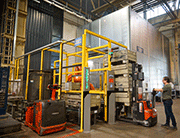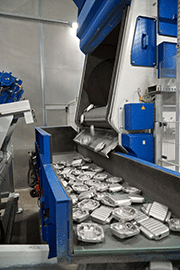Two leading manufacturers in their respective sectors have decided to launch a joint project in the area of surface technology. The result of this is an automated blasting cell for mass-produced castings.
AGTOS is a manufacturer of shot blasting machinery operating on an international level. In addition to reliable, high-performance blasting technology, the company has extensive know-how in the area of workpiece handling and process optimisation.
SEW presentation
The SEW Group is a family enterprise operating all over the world, and SEW is a globally known name in the area of drive systems.
Around 475 personnel are employed at the SEW USOCOME plant in Forbach, France. This facility is the aluminium component competence centre for the SEW Group.
A new AGTOS rubber belt tumble blast machine was installed here recently for post-processing of covers for terminal boxes and gearboxes.
The blasting objective is the deburring of parts and creation of a uniform surface. Parts are washed and then painted following blasting.
Situation analysis
Workpieces (covers for terminal boxes and gearboxes) were processed in a rubber belt tumble blast machine. This was manually loaded and unloaded and, as a consequence, had a longer cycle time. The number and variety of parts had also grown over the years, meaning that the capacity could no longer be achieved. There was evidently a need for a machine delivering a higher level of performance.
The effort involved in handling parts was too great. As the blasting machine represented a bottleneck, it was necessary to provide interim storage for the finished castings before processing them in the blasting machine. This required space, time and labour.
During planning, an idea matured with regard to time integration of the new machine in the process. The storage between casting and blasting was to be avoided, which entailed designing the machine so that it could blast quicker than new parts emerge from production. "Employees were to be relieved of tasks that do not directly add value to the workpieces", says Romain Zorzi, Project Manager for New Processes.
Surface technology solution
The tip to consider AGTOS as a blasting technology provider came from the blasting abrasive manufacturer. Workpieces were initially blasted in the AGTOS plant and that of another customer to test performance. The abrasive and machine were optimally coordinated during this, with the results being so positive and the cover of the workpieces so good that it was decided to purchase the new blasting machine from AGTOS.
This was followed by a phase involving concrete tests and calculations, with technicians from both companies working closely together to realise these. The solution is really impressive. In terms of design, manual loading and unloading of the blasting machine was initially retained. The elimination of interim storage on its own was a decisive advantage. The new blasting machine has a lower cycle time and is more efficient in terms of its overall blasting technology.
Prior to commencing installation, individual installation and implementation steps were defined during the course of a meeting. It became clear that positioning and installation of the assemblies delivered on schedule at the site posed a logistical challenge. Several suppliers and SEW needed to work hand in hand in this respect (blasting machine, crane, lift platform, energy, pneumatics). A major site developed during installation. The blasting machine was set up and connected while adjacent machinery continued operating. A complete noise reduction enclosure was simultaneously constructed. "The machine has been operating without any problems since installation, and the cycle time is perfect", confirms Romain Zorzi.
Following installation of the machine, operation was changed from manual to robot loading. This is where technicians from SEW and AGTOS truly worked hand in hand. In addition, it was necessary to cover the range of parts to be processed with a single blasting program. This task was solved by AGTOS. Quality and the cycle time for workpieces were defined at the outset in the specification, and optimum blasting parameters were determined through testing.
Today, the workpieces are only deposited in transport boxes in front of the blasting cell by the forklift driver, and finished parts are collected and conveyed away. Processing in itself is completely automatic. "You could say that the process has been simplified, because handling has been drastically reduced", says Zorzi.
Following blasting, the workpieces are returned to the same transport boxes they were delivered in. This enhances the transparency of the process, and certification of quality is simplified.
Process sequence in the blasting cell
Several workpiece boxes are delivered by forklift to the blasting cell and placed on a roller conveyor there. The robot picks up the boxes individually and places them in a feeding system. This tips the workpieces into the opened trough on the blasting machine. The rubber belt moves after the door closes and mixes the parts, ensuring that turning of the workpieces is gentle. Maintaining low gap dimensions in the blasting machine interior means that even very small parts can be blasted.
The high-performance turbine located above blasts abrasive at the workpieces, reaching all surfaces as a result of the turning action. The abrasive is collected beneath the machine, precleaned and conveyed to the upper part of the machine. Further separation of dust and undersized particles from the abrasive is achieved here through an air stream. A wet filter unit creates the required negative pressure for this purpose. The cleaned abrasive is then made available again to the high-performance turbines and, consequently, the complete cycle.
Following blasting, the door opens and the rubber belt changes its direction of travel. The workpieces are gently directed as a result towards a vibrating channel that takes them to a conveyor belt which leads to the box filling system. The filled box is picked up again by the robot and placed in a removal area. The box in turn is taken from here by forklift to the next processing step.
Competence in shot blasting technology
AGTOS blast machines are distinguished by a high degree of robustness, a long service life and maintenance-friendliness. The high-performance turbines are designed to ensure extremely low wear, even in the severest of operating conditions. Moreover, they are capable of a high abrasive shot flow rate while requiring the same amount of energy as other turbines. They are extremely efficient as a result. The blasting chamber itself is lined with replaceable, highly wear-resistant manganese and tool steel plates.
AGTOS customers always emphasis the high level of maintenance-friendliness of these blasting machines. The entire machine is not only designed for long-term operation, but optimised for maintenance and the replacement of spare and wear parts. For example, AGTOS high-performance turbines are equipped with easily replaceable turbine blades.
Other servicing work such as replacement of the rubber belt can be quickly realised, thanks to a well-designed maintenance system.
About AGTOS
AGTOS was founded in 2001 in Emsdetten by employees with experience in this area. Now, more than 160 employees are employed at the two sites. In Emsdetten, the headquarters of the company, the concepts are developed and the turbine-wheel blasting machines designed. The manufacturing site is located in the Polish city of Konin, near Poznań.
The constant focus on the requirements of the customers has led to the fact that the company is regarded as a specialist in the design and manufacture of turbine-wheel blasting equipment for roughing, cleaning, removing rust, descaling and hardening. Therefore, customers on all five continents work with the shot-blasting machines from AGTOS.
In addition to new shot-blasting machinery, AGTOS also offers used blasting systems. This is an advantage for customers who need a blasting machine at very short notice or only wish to use it temporarily.
The abrasive used in shot-blasting machines not only affects workpieces surfaces, as the abrasive impact is also noticeable in the blasting machines themselves. This is why service, meaning stocking and delivery and the installation of spare and wear parts, plays an important role. Added to this are maintenance, repair and modernisation work on machines from other manufacturers which are at all times realised by experienced skilled personnel.
For Information:
AGTOS
Gutenbergstr.14
48282 Emsdetten, Germany
Tel. +49.2572.96026-0
E-mail: info@agtos.de
www.agtos.de


































